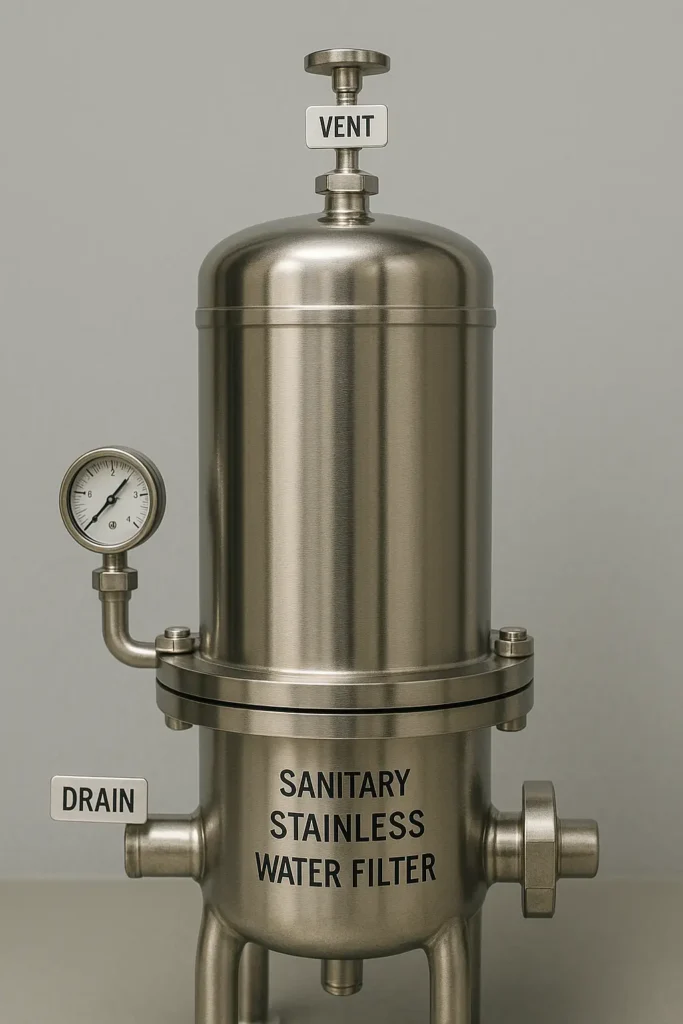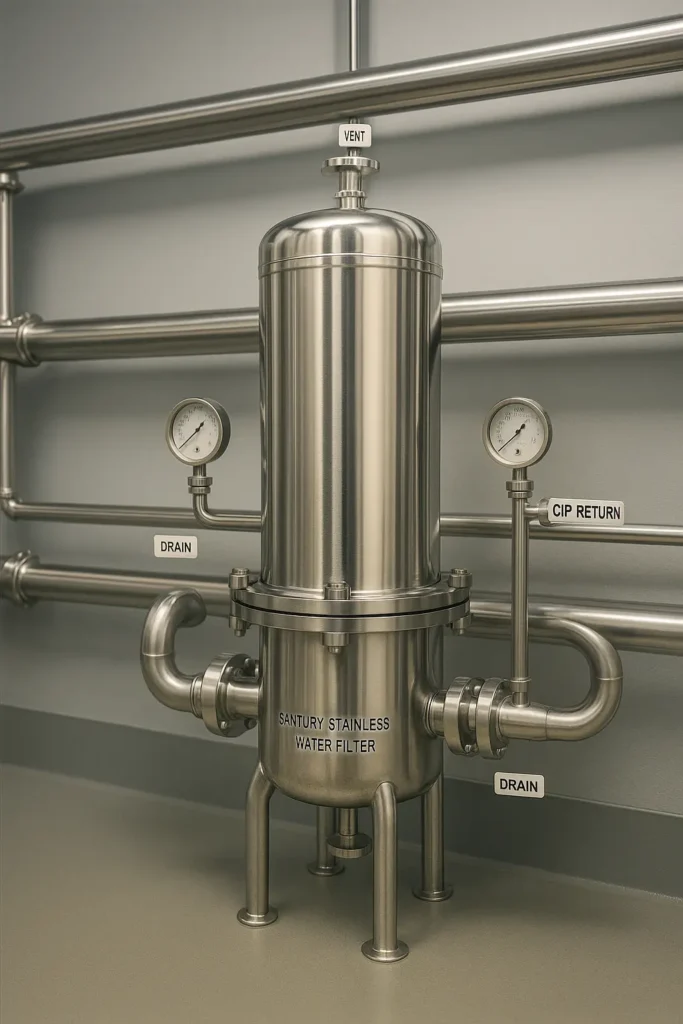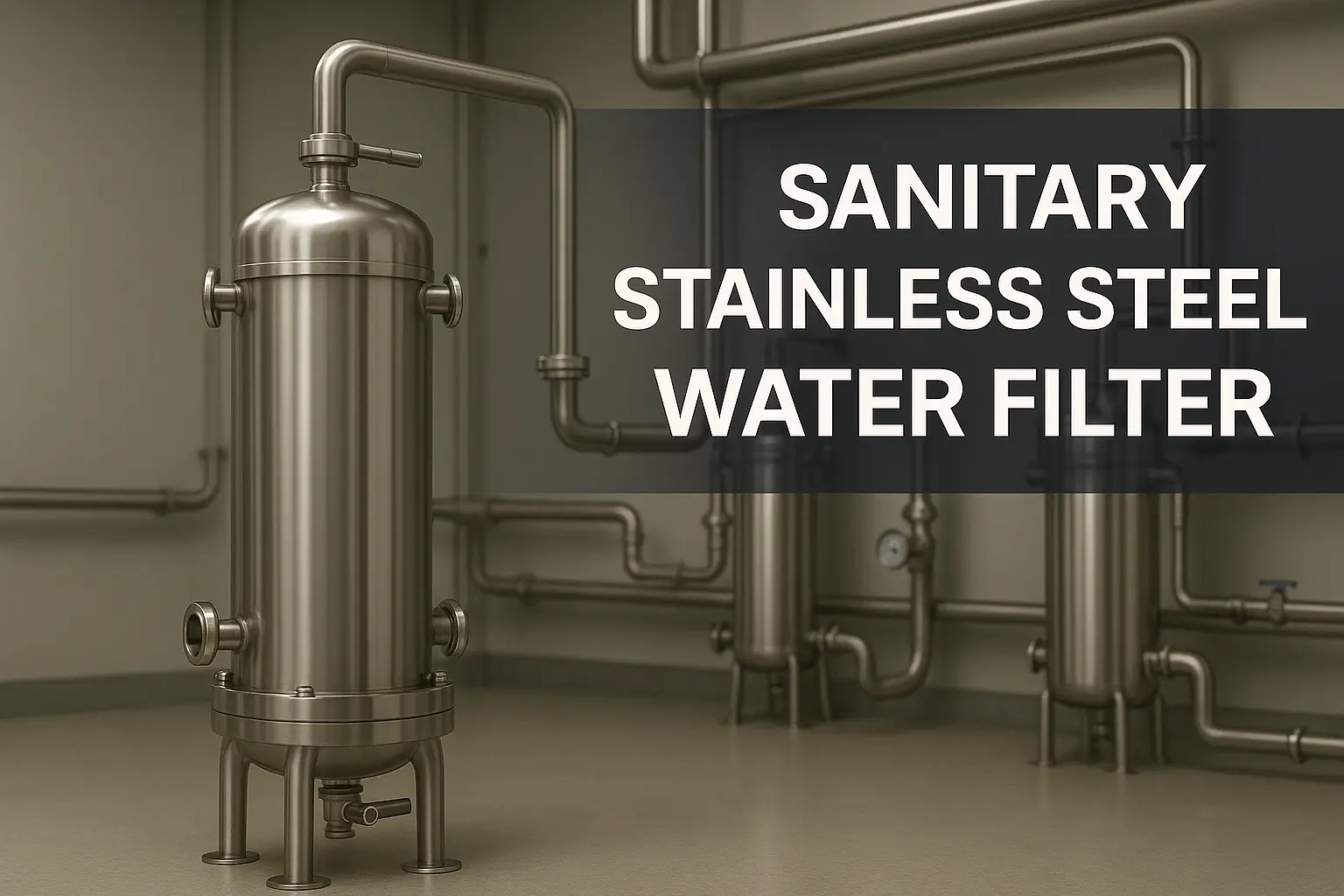Sanitary stainless steel water filter systems are used wherever hygienic design, cleanability and material traceability are mandatory—food & beverage, pharma PW/HPW/WFI pretreatment, biotech utilities, high-purity blending and point-of-use polishing. This practical guide explains what makes a filter “sanitary”, how to size it (flow → area → ΔP), how to run CIP/SIP correctly, and what documentation plants expect during FAT/SAT and validation.
Quick action: need a ready-to-buy configuration? Browse our stainless portfolio here → Produkte aus rostfreiem Stahl.
1) What makes a sanitary stainless steel water filter “sanitary”
- Connections & geometry: tri-clamp (clamp ferrules), minimal crevices, short hygienic welds, full drainability, vent at the top and drain at the lowest point.
- Surface finish: inside Ra often ≤0.8 μm for sanitary duty; electropolish (EP) reduces micro-roughness and improves cleanability.
- Materials & traceability: 304/316L with mill certificates; elastomers (EPDM/FKM/PTFE) with certificates of compliance; gasket grooves designed for full sealing and easy inspection.
- Dokumentation: MTR/3.1 certs, weld map, passivation or EP certificate, pressure test record, FAT/SAT reports, IQ/OQ templates.

2) Where sanitary stainless steel water filters fit
- Food & beverage: syrup/water blending, ingredient dosing, final polishing before fillers.
- Pharma/biotech: PW/HPW/WFI pretreatment steps, point-of-use polishing, utilities and buffer prep lines.
- Electronics/UPW support: pre-RO polishing, carbon fines removal, point-of-use protection on tools.
3) Housing design essentials (sanitary vs. industrial)
- Headplate & shell: crevice-free seat, O-ring retained with visual inspection; lift-assist or swing-bolt caps sized for safe opening.
- Ports: top sanitary vent (sterile air option), bottom sanitary drain; DP ports (PI/P2) for ΔP tracking; optional RTD/pressure transmitters.
- Vertical orientation: improves drainability and CIP coverage; keep piping slopes ≥1% toward drain.
- Multi-cartridge vs. single: multi for high flow main lines; single for point-of-use polishing.
4) Materials, surface finish & chloride limits
For a sanitary stainless steel water filter, choose the grade by chloride + temperature and by hygienic finish needs:
| Option | Typical use | Anmerkungen |
|---|---|---|
| 304 | Ambient, low-chloride utilities | Cost-effective; avoid hot/high-Cl⁻ washdowns. |
| 316L | Hot water, higher chloride, CIP with chlorides | Better pitting resistance; pharma/food default for hot duty. |
| Electropolished 316L | High hygiene, frequent CIP/SIP | Lower Ra, less bio-harboring; smoother cleaning validation. |
Rule-of-thumb: if temperature >50 °C or chloride >50–100 mg/L, review pitting risk and consider 316L + EP; for aggressive detergents or mixed oxidants, validate elastomer compatibility.
5) CIP/SIP for a sanitary stainless steel water filter
- CIP flow velocity: target ~1.5–2.0 m/s in the housing loop for mechanical cleaning energy.
- Chemistries (examples): 1–2% caustic (50–60 °C), mild acid rinse (citric/phosphoric), final WFI/PW or RO permeate rinse; avoid free chlorine on polyamide-based filters.
- SIP: saturated steam 121 °C for 20–30 min (or per filter media OEM). Use steam-in place with controlled ramp/condensate drain; verify elastomer and media ratings.
- Validation: define cycle, temperature profile, ΔP acceptance, and microbial endpoints; document lot numbers for membranes/cartridges/elastomers.
Chemical compatibility (typical)
| Media/Gasket | Caustic | Acid | Oxidationsmittel | Steam |
|---|---|---|---|---|
| Polypropylene (PP) cartridge | Good | Fair-Good | Poor | Fair |
| PES membrane | Good | Good | Fair | Good |
| PTFE membrane | Excellent | Excellent | Good | Excellent |
| EPDM gasket | Good | Good | Fair | Good |
| FKM/Viton gasket | Good | Good | Good | Fair |
| PTFE gasket | Excellent | Excellent | Excellent | Excellent |
Compatibility is media- and concentration-dependent; confirm with the cartridge/gasket OEM data before approving a CIP/SIP recipe.
6) Sizing a sanitary stainless steel water filter (flow → area → ΔP)
- Define design flow & viscosity (max flow, temperature window).
- Select target micron & media (absolute vs nominal; PP/PES/PTFE; carbon fines or bioburden control).
- Estimate clean ΔP from the cartridge datasheet at the flow per element; add housing losses and margin.
- Set terminal ΔP (often 1.5–2.0 bar for sanitary duty) and change-out philosophy (ΔP or time).
Worked example (sanitary main line)
Goal: 12 m³/h PW at 25 °C, 5 μm absolute PP cartridges, clean ΔP target ≤0.3 bar, terminal ΔP 1.5 bar.
- Datasheet (example): one 30″ cartridge passes 1.2 m³/h at 0.05 bar (clean).
- Needed cartridges for clean ΔP ≤0.3 bar ≈ (12 / 1.2) × (0.05 / 0.3) ≈ ~17 → choose a 20-cartridge sanitary housing for margin.
- Satz change-out at 1.5 bar ΔP or 4–8 weeks (whichever first), record lot/ΔP vs time.

7) Installation & piping for sanitary service
- Vertical mount, vent at the very top; slope upstream/downstream piping to drains; avoid dead-legs >2D.
- Instrumentierung: PI (in/out), ΔP transmitter (optional), RTD for temperature; sample valve downstream.
- Access: clearance above cap for cartridge change; hoist/lift-assist if multi-cartridge; safe drain to floor drain.
8) QA & validation package
- MTR/3.1 with heat numbers; PMI where required.
- Weld log & NDT (if specified); passivation/EP certificate; hydrostatic pressure test record.
- FAT/SAT results; IQ/OQ templates; cleaning validation summary with acceptance criteria.
9) Cost & lifecycle (TCO)
Compared with plastic/FRP, a sanitary stainless steel water filter has higher CAPEX but lower downtime and better cleanability. Media change-out and validated CIP cycles typically drive OPEX; good sizing reduces premature fouling and bioburden risk.
Further reading on hygienic design: EHEDG Hygienic Design Principles - 3-A Hygienestandards.
Materials & chloride limits: Nickel Institute — Stainless steels in potable water, BSSA chloride/pitting guidance, NSF/ANSI 61 overview.
CIP/SIP & elastomers: eCFR 21 CFR 177.2600, Spirax Sarco SIP knowledge.
Validation frameworks: ASME BPE, ISO 2852 (sanitary clamp), EPA drinking water reference.
10) Ready-to-buy configurations
- Sanitary point-of-use (1–3 cartridges): tri-clamp, Ra≤0.8 μm, EPDM/PTFE gaskets — browse options.
- Sanitary multi-cartridge (10–30 cartridges): main line polishing, full drainability, DP ports — see stainless housings.
- Sanitary bag filter (duplex) for high-load pre-polish: where sanitary piping is still required — check configurations.
11) FAQs — sanitary stainless steel water filter
Do I always need 316L for sanitary duty?No. For ambient, low-chloride utilities 304 may be adequate, but hot water or higher chloride favors 316L; add electropolish when hygiene and frequent CIP are required.What surface finish should I specify?Ra ≤0.8 μm is common for sanitary lines; electropolish provides smoother surfaces and easier cleaning validation.Can I steam-sterilize the housing with cartridges installed?Only if the specific cartridge media is rated for SIP; otherwise remove cartridges or use SIP-rated sterilizing-grade elements.How do I set the change-out?Use ΔP (e.g., 1.5 bar terminal), time limit in critical services, and microbiological monitoring where required.What documents are typically required?MTR/3.1, weld map, passivation/EP cert, hydrotest, FAT/SAT records, and IQ/OQ templates with cleaning validation summary.
12) Next steps
Send your feed spec (flow, temperature, chloride, target micron, hygienic standard) and we’ll propose a sanitary stainless steel water filter configuration within 24 hours.
Browse Stainless Filters Angebot anfordern
Lesen Sie weiter: hygienic design references from 3-A/EHEDG (reference only). Verify all chemical and temperature limits with the media OEM before approving CIP/SIP recipes.

